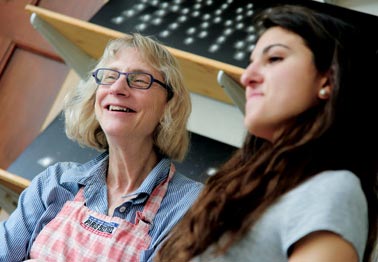
Maggie Stark
Visual Arts Department
Member of the Faculty, 1986–2017
 Practicing artist, gallery director, parent and innovative teacher, Maggie Stark has had to be a proficient juggler during her 37 years at Milton. Like all the best jugglers, she managed that skill so self-effacingly that after a while the eggs seemed to be circling of their own accord.
Practicing artist, gallery director, parent and innovative teacher, Maggie Stark has had to be a proficient juggler during her 37 years at Milton. Like all the best jugglers, she managed that skill so self-effacingly that after a while the eggs seemed to be circling of their own accord.
Years before the creation of innovation labs and “maker spaces,” Maggie was already connecting art and science through design. Her 3-D Studio Art course was groundbreaking for Milton and for secondary education. Maggie provided an important role model, especially for girls in a traditionally male realm. Often using books as triggers, Maggie connected the designer’s world of space and form to the world of ideas. Eighth graders would channel what they’d read into tile designs for the Middle School common room. Ninth graders would transmute fairy tales into a suite of murals for the town library. Older students in the 3-D Studio Art course would progress from building a functional chair out of cardboard to designing a conceptual clock based on Alan Lightman’s novel Einstein’s Dreams.
Maggie’s professional work as an artist and designer animated her teaching. Her classroom doubled as her studio space and was filled with silver mirror balls, glowing glass tubes, and light boxes. As with her recent “Timelock” series, her many “high- tech” exhibits, contemporary in all respects, have captured human struggles in meta-physical terms. Her reach as an artist and educator extended to fellowships that took her to Germany and to South Korea.
Maggie’s commitment to Milton extended beyond the classroom. Her 11 years as director of the Nesto Gallery produced a stream of memorable shows. Her leadership in designing and installing the playground at the Milton Academy Children’s Center was permanently commemorated when grateful colleagues inscribed her name in the concrete apron there.
Looking back, Maggie thanks Milton for the freedom it gave her as a teacher. The School should be at least equally grateful for the energy, inventiveness and dedication she brought to the challenges freedom presents. She feels that since she came to Milton, students’ attitudes toward art have evolved in positive ways—that, particularly, there is a stronger sense of the thrill of making things. If this is so, much of the credit belongs to her.
Gordon Chase, Former Visual Arts Department Chair
Ian Torney ’82, Visual Arts Department Chair
David Smith, Former English Department Chair




